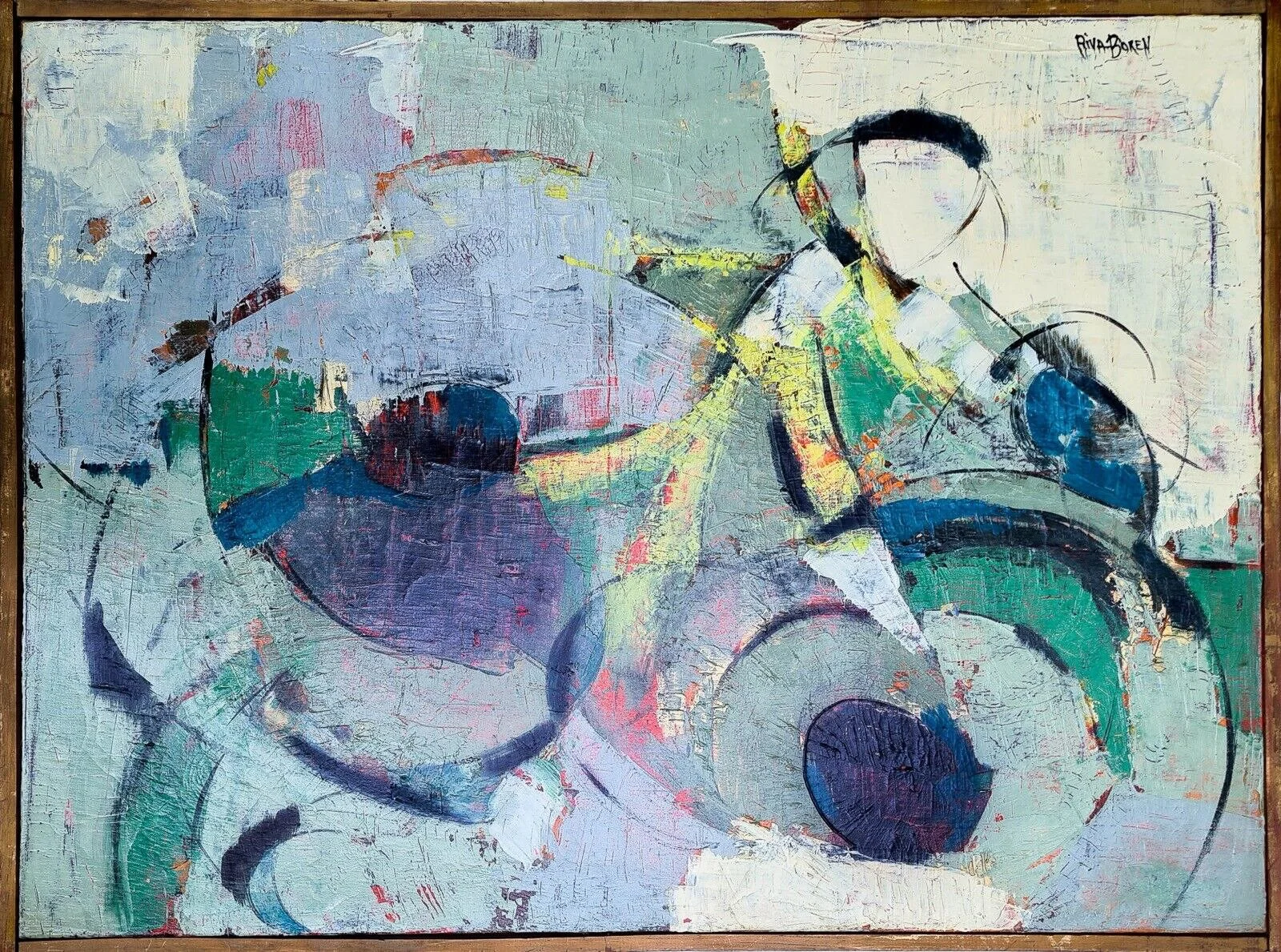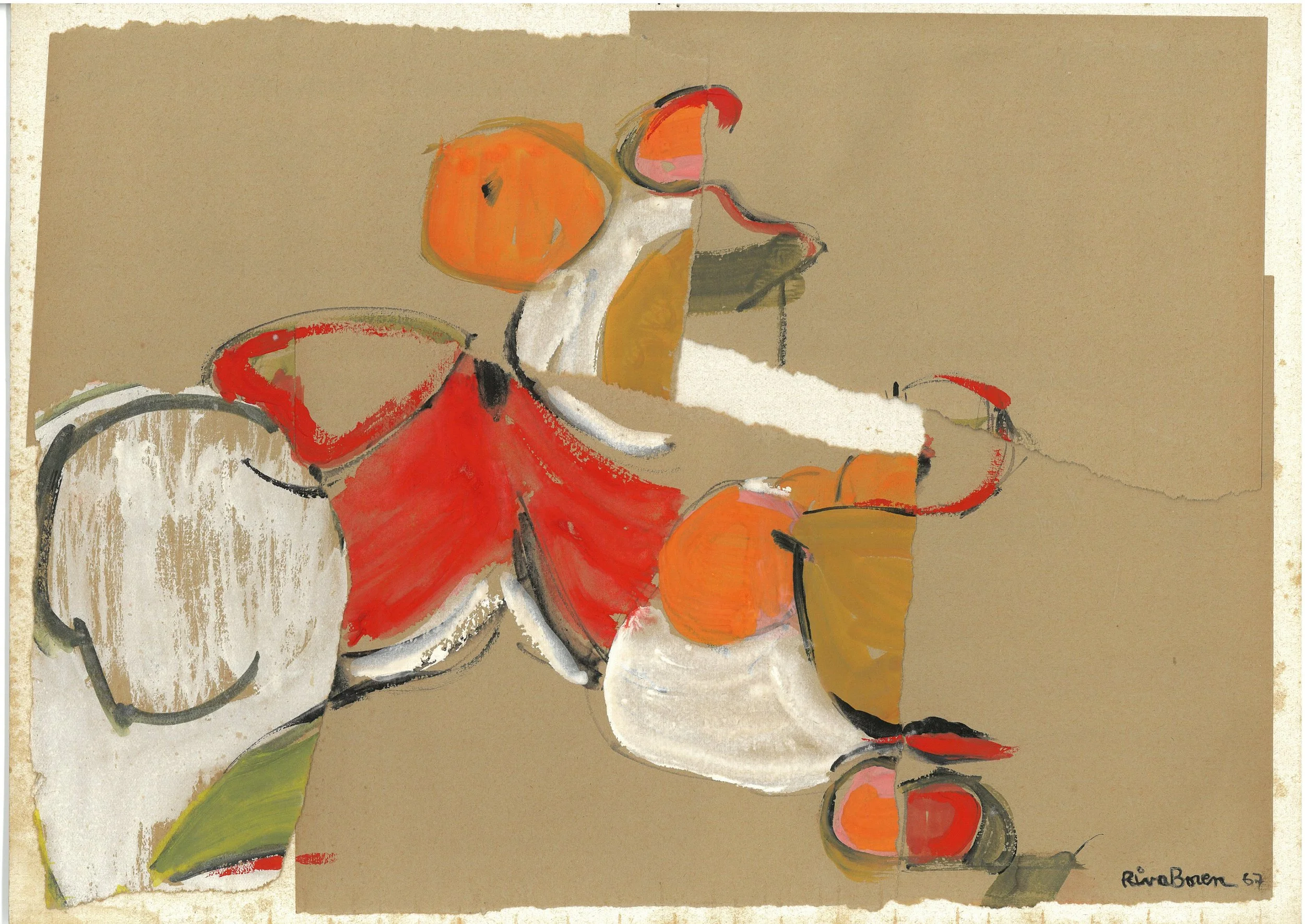the Survivor
Riva Boren
French Artist
B/D
1926—1995
Riva Boren, née Borensztejn, was born in Paris, France, to Ukrainian and Polish emigres who escaped the Red Army in the early 1900s. It is believed her parents met at the Rovno refugee camp just before the Russian Revolution. Subsequently, they both fled to Paris and created a small embroidery and sewing company, fondly naming it the “Odessa Sewing Company” in remembrance of her mother’s homeland. These early images of her parent’s most likely played a significant role in Riva’s vivid pastel pallet where she seamlessly sewed pieces of her artwork together on her celebrated ‘kraft’ paper, a traditional thick brown Nepalese paper that was able to absorb pastels and washes, her preferred canvas and artist style until her death in 1995.
There is no doubt that Riva Boren was a tour de force throughout her life. She was glamorous with a personality to match; often referred to as seductive and fearless with a dark history, drowned in the loss of family members to the Holocaust, Riva was the only member of her family who survived.
“My grandmother spoke to me of the war every morning. She was forced into hiding from the Nazi’s when as she was only thirteen or fourteen years old. This is what made her such a strong, fierce person,” says Doris Lanzmann, Riva’s beloved granddaughter, who spent nearly every day with her grandmother until her grandmother died when she was 8 years old. Riva’s horrors were compounded by her mother’s unwavering grief and her longing to be reunited with her already captured husband and son; therefore, she would openly roam the streets of Paris, wanting to be captured by the Gestapo in the hopes of rejoining her husband and son.
Riva Borensztejn painting en plein air while studying Fine Arts in Paris
“By the age of 14 Riva realized, due to her mother’s actions it was unsafe to be seen with her and began a life of hiding from her mother and dodging arrest from the Nazi’s, Eventually, Riva’s mother was seized and taken on the infamous number 77, the last wagon to appear in Paris.”
— Doris Lanzmann, Riva’s beloved granddaughter
Although it is believed they remained in contact and Riva from afar witnessed her mother being taken away, for nearly four, perhaps five years, she took refuge in bathrooms and attics. At one point, she joined a girl street gang that allegedly helped to liberate Paris. Some accountants describe Riva as transporting ammunition and escaping gunfire by hiding underneath abandoned German tanks. At the end of the war, after years of hiding, Riva, now a young woman, fled to New York to stay with her mother’s sisters. In New York, she became a nightclub singer, a fashion model, and developed a keen interest in and began studying the fine arts. She briefly studied in New York but returned to Paris to study at the Académie de la Grande Chaumière. After her studies, she once again returned to New York to marry an artist associated with the Academie. Theirs was a brief marriage, after which Riva again returned to France.
It was in Paris in 1955 where Rita began engaging with the art scene at Montparnasse and met her second husband, Jacques Lanzmann. Lanzmann went on to significant fame as a lyricist, writer, and cinematographer, promoted by his dear friend, the renowned feminist writer Simone de Beauvoir, Sartre’s lover and author of The Second Sex (1949). Rita and Jacques became part of the legendary circle of artists and writers in Montparnasse. Together, they had a son, Métier, but their marriage only lasted for two years. In Lanzmann’s biography, The Thief of Chances (1976), he describes Riva as a stunningly beautiful woman who was deeply wounded. “France’s dark years never ended for her,” he wrote. Lanzmann’s brother, Claude, was famed for developing the legendary documentary SHOAH, depicting the plight of the holocaust victims.
With her challenges, pain, and sacrifices, Riva continued exploring and pursuing her art career. Unlike so many artists, especially women, she was able to make a living with art by selling her paintings and teaching. Albert Loeb, the distinguished gallerist, founder of the Galerie Albert Loeb, met Riva through his sister.
“I have only ever shown artists I like, and I liked Riva’s work, and clients loved her work; her shows would always sell out.”
— Albert Loeb, founder of the Galerie Albert Loeb,
Her early abstract paintings are considered post-war and contemporary. She, like Cameron, was considered an avant-garde artist, especially when she began trekking to Nepal in 1972, where she came upon Tibetan refugees who perhaps helped her to overcome and work through some of her past traumas. Inspired by the Tibetan nomads, Riva began using pastels to draw faceless images (often handless as well) of Tibetan refugees on traditional brown Nepalese paper, sewing pieces of her composition to create colorful images of forgotten peoples. “I think she projected her own story onto the story of the wandering Tibetans and what was happening to their homeland; in some ways, this happened to Riva. I believe these veiled faces are the faces she lost in the holocaust,” conveys her granddaughter, Doris.
Simone de Beauvoir wrote of Riva; Riva Boren has made a clear choice. Like a musician who, composing a melody, feels the need to integrate the richness of an articulated language, she feels the necessity of rooting her works in the depth of the world. She prefers the inexhaustible resources of living bodies over inert objects, hence the series of paintings she has just completed.
Pierre Nachbaur, a contemporary and modern art dealer, specialist, and collector, was Riva’s confidante and close friend until her death. He speaks of her passion with Tibet. “She was deeply devoted to her Buddhist practice, yes, she went to India and Tibet at a time when it was what the counterculture was doing, but this became her inspiration for working with pastels; she no longer felt abstract painting was as interesting.”
Riva was deeply affected by her annual trips to India and Nepal. She became a practicing Buddhist; she would meditate, chant, and had several rinpoches (master teachers or gurus) that she studied and worked with during her visits. “Although her body was succumbing to cancer, she walked the Himalayas to meet the new Dali Lama, she wanted to be present; she was a real tough cookie,” says Pierre. In her own words, Rita journaled: The years of my journey have allowed me to understand my relationships with others more meaningfully, and especially my relationship with myself. Teachings, encounters, silences have brought me a discipline in my work—a work that reflects this journey and the pursuit of being in full light.
“Riva was a bit forgotten, Her works and words, however, still exist with new eyes to look upon them, and perhaps now she will come out of the shadows”
— Emmanuel Pierrat, a prominent attorney and celebrated agent for artists, as well as an art collector.
Riva Boren died of lung cancer in 1995.
To my father
To my mother
My brother
I have seen made-up faces,
I have seen powdered faces,
I have seen greased faces,
I have seen lifted faces,
I have seen masked faces,
I have seen prepared faces,
I have seen studied faces,
I have seen coated faces,
I have seen wrapped faces,
I have seen falsified faces,
I have seen composed faces,
I have seen tricked faces,
I have seen worn-out faces,
I have seen stolen faces,
I have seen reserved faces,
I have seen concealed faces.
The truth
I have seen veiled faces, of serenity
Rive Boren
ARTWORK
Sans Titre, 1985, Pastel on kraft paper, 147 x 110 cm.
Sans Titre, 1985, Pastel on kraft paper, 154 x 73 cm.
Sans Titre, 1985, Pastel on kraft paper, 147 x 110 cm.
Sans Titre, 1985, Pastel on kraft paper, 147 x 110 cm.
Sans Titre, 1985, Pastel on kraft paper, 155 x 190 cm.
Sans Titre, 1985, Pastel on kraft paper, 140 x 98 cm.
Sans Titre, 1985, Pastel on kraft paper, 100 x 130 cm.
Composition Abstraite, 1960, Oil on Canvas, 21 x 29 in.
Natures mortes aux fruits, Drawing-Watercolor, Pastel, collage/papier, 10 3/8 x 14 in.
Natures mortes aux fruits, 1967. Drawing-Watercolor, Gouache, aquarelle, collage/papier, 10 x 14 in.
Natures mortes aux fruits, 1967, Drawing-Watercolor, Gouache, aquarelle, collage/papier, 10 x 14 in.
Natures mortes aux fruits, Drawing-Watercolor, Pastel, collage/papier, 10 3/8 x 14 in.













